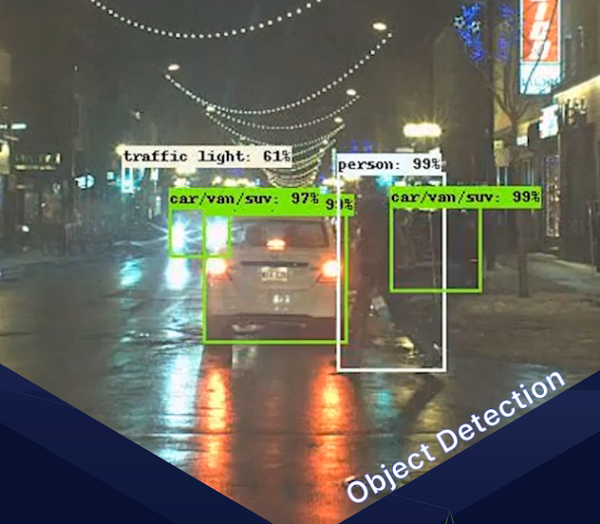Computer Vision Software Startup Algolux Brings In $18.4M in Series B Funding

Algolux, a computer vision startup that builds software for advanced driver assistance systems (ADAS) and for autonomous vehicles, has secured $18.4 million in new Series B funding from a group of investors that includes General Motors’ investment division, GM Ventures.
The new funding, which raises the Montreal, Canada-based company’s total funding to $31.8 million so far, was co-led by investors Forte Ventures and Drive Capital. Other investors include Investissement Quebec, Castor Ventures, Nikon-SBI Innovation Fund, GM Ventures, Generation Ventures and Intact Ventures.
The fresh influx of cash will be used by Algolux to help promote and grow the company’s computer vision and image optimization technologies with vehicle makers so they can use them with their future vehicles, according to the company. Algolux will also use the money to expand its engineering and marketing teams, while also exploring additional vertical markets for its technologies. The latest funding round was announced by Algolux on July 12 (Monday).
The company’s computer vision software is used with in-vehicle cameras as part of ADAS and autonomous vehicles in a market that is continuing to grow in use and popularity.
“Unfortunately, vision – the most widely deployed component of the overall perception stack – is still hampered by performance issues in low light and poor weather conditions making SAE Levels 2 and above more challenging to support,” the company said in its press release.
To battle this problem, Algolux uses computational imaging to design algorithms that treat the camera as part of the overall perception stack, which is a departure from the traditional siloed approach, according to the company. This approach resolves problems such as low light, low contrast and obstructions for object detection, imaging and geometric estimation, which provides clearer images and resolution. The use of the physical camera models also reduces training data needs by an order of magnitude, resulting in Algolux technologies outperforming commercial solutions by as much as 60 points in mean average precision (mAP), according to the company.
“We are thrilled to be taking this next step in the company’s trajectory and to do so with the trust and support of outstanding investors,” Allan Benchetrit, the CEO of Algolux, said in a statement. “Algolux is actively engaged with leading OEMs, Tier 1s, and Tier 2s globally. The consistent theme is a desire from customers to significantly improve the performance of their driving and parking vision systems in even the most challenging real-world situations.”
Max Leblond, the marketing manager for Algolux, said he could not comment on which vehicle makers might be testing or using the company’s software. “We have been in discussions and testing our products with OEM and Tier 1 vehicle parts suppliers,” he said. One of the company’s applications is for camera optimization, while the other is an embedded camera application used for visual perception.
Shelly Kramer, a founding partner and lead analyst with Futurum Research, told EnterpriseAI that Algolux’s latest funding news is an indicator of just how important computer vision is and how it will continue to move forward in the automotive sector.
“The fact that camera-based advanced driver assistance systems are table stakes when it comes to driving experiences today – both driver-led and autonomous – combined with the fact that camera tech still has a long way to go in terms of functionality and accuracy, means this is good news for the industry,” said Kramer. “Algolux's computational imaging as part of the algorithm design process bodes well for all those days when my car's camera tells me it can't see because of weather conditions — and for the computer vision industry and the automotive industries. This is especially good news for the trucking industry and autonomous vehicles. This is an industry, and a company, to watch.”
James Kobielus, senior research director for data communications and management at TDWI, a data analytics consultancy, said the computer vision market today is “extraordinarily overcrowded” and that its use for automotive safety still has a long way to go before it is ready for primetime deployment.
“I am impressed with Algolux’s focus on AI-powered cameras for robust perception in all conditions,” said Kobielus. “It approaches visual imaging as an integral, but not self-sufficient, component of the automotive perception stack. Without supplementary sensing inputs--such as radar, LiDAR, infrared, and ultrasound—and the composite AI to tie it all together in real time, automotive computer vision systems are extremely prone to mistakes from ever-present visual phenomena, such as low lighting, low contrast, and obstructed sightlines.”
The larger trend in the marketplace is the deployment of AI-driven perception stacks in which computer vision is essentially the sum of all sensor inputs that can be rendered as visual patterns, said Kobielus.
“Through sophisticated AI, it is increasingly possible to infer a highly accurate visual portrait from the radio frequency signals that people and objects reflect, the pressure and vibrations they generate, and the heat patterns that they radiate,” he said. “Algolux will need the funding to invest in the R&D necessary to improve its composite AI and to work with industry partners to build it into the ASICs necessary for ADAS safety applications.”













